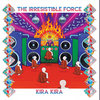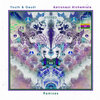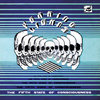Spectral Manifold ℝ⁴ by Dubsahara
Tracklist
Credits
released December 21, 2024
Movement flows without beginning or end, cycles too vast to trace. Patterns arise in this ceaseless interplay—fleeting yet intricate, ever in motion. This is neither a moment of arrival nor a story of completion. It is a reflection of harmonies shaped between worlds. It speaks to rhythms of becoming unbecome—where cycles rise and fall, endless in the flow.
____________________________________________________________
Exploring Sound as a Manifold
A sound occupies a position in a high-dimensional manifold where each dimension represents a spectral component. This spectral manifold exhibits continuous differentiable properties, allowing examination through differential geometry.
The basic structure consists of frequency amplitudes as coordinates. For any given moment, a sound's position in the manifold is defined by its frequency spectrum {f₁...fₙ}, where each fᵢ represents the amplitude at a specific frequency. The tangent space at each point represents possible instantaneous changes in this spectrum.
This manifold possesses natural curvature arising from physical constraints. Conservation of energy creates boundaries and affects possible trajectories between spectral states. Phase relationships between frequency components introduce additional geometric structure through interference patterns.
The manifold topology includes several notable features:
Local neighborhoods representing similar timbres cluster together
Paths between spectral states follow energy gradients
Stable points emerge where multiple trajectories converge
Regions of high spectral density create areas of increased curvature
Phase relationships generate periodic structures
Time evolution of sound appears as trajectories through this space. A sustained tone traces a small loop or point-like region. A transforming sound draws a path through multiple spectral regions. Multiple simultaneous sounds create higher-dimensional manifold projections.
Distance in this space correlates with perceptual difference. Nearby points generally represent similar-sounding spectra. However, the relationship between geometric and perceptual distance remains complex due to psychoacoustic factors.
The manifold exhibits both local and global structure. Locally, it resembles Euclidean space. Globally, it contains complex topological features including:
Periodic boundary conditions from phase relationships
Singularities at points of perfect destructive interference
Regions of varying dimensionality based on spectral complexity
Natural constraints from physical conservation laws
Examining specific trajectories reveals patterns of spectral motion:
Smooth curves during continuous transformation
Rapid jumps between stable regions
Orbital patterns in sustained sounds
Spiral paths in decay processes
The dimensionality varies with spectral complexity. Simple tones occupy low-dimensional submanifolds. Complex sounds inhabit higher-dimensional regions. The full manifold includes all possible spectral configurations.
Metric structure emerges from energy relationships between spectral components. This allows quantification of distances between spectral states and analysis of path lengths through the space.
Phase space analysis reveals additional structure. Each frequency component contributes both position and momentum coordinates, doubling the manifold dimensionality but revealing dynamic patterns.
Time enters as both:
Parameter along trajectories
Component of the manifold structure itself through frequency relationships
Energy appears as:
Constraint on possible trajectories
Factor in metric structure
Generator of manifold curvature
The manifold contains substructures:
Harmonic lattices from frequency relationships
Stability regions around energy minima
High-curvature boundaries at physical limits
Interconnected phase relationship networks
Scale-dependent features emerge at different levels:
Microsonic: Wave interaction geometry
Mesoscopic: Spectral evolution patterns
Macroscopic: Overall transformation paths
Each point in the manifold represents a possible spectral state. Collections of points form regions representing classes of related sounds. Boundaries between regions correspond to perceptual transitions.
This manifold structure provides a geometric framework for examining spectral motion without imposing specific theoretical interpretations. The patterns and relationships emerge from the inherent mathematics of sound spectra evolving through time.
________________________________________________________________
Perceptual Manifolds and Sensory Correlation
The perceptual manifold exists in parallel to the physical spectral manifold, connected through psychoacoustic mappings. This perceptual space exhibits distinct topological properties arising from sensory processing.
Neural response patterns create a transformed manifold structure where:
Frequency relationships map logarithmically
Amplitude follows power-law scaling
Temporal integration creates hysteresis effects
Critical bands form natural clustering regions
Masking effects distort local geometry
The mapping between spectral and perceptual manifolds reveals:
Non-linear warping of frequency relationships
Compression of dynamic range
Enhancement of spectral edges
Integration of temporal windows
Formation of gestalt units
Correlation patterns emerge between:
Auditory Parameters
Pitch height
Spectral density
Temporal evolution
Spatial position
Timbral qualities
Cross-Modal Mappings
Brightness correlates with spectral centroid
Weight corresponds to spectral density
Texture maps to temporal granularity
Size relates to spectral spread
Motion links to spectral flux
The perceptual manifold exhibits:
Regions of heightened sensitivity
Perceptual boundaries
Categorical perception zones
Attention-dependent metrics
Memory-influenced topology
Integration windows create temporal structure:
Sub-50ms: fusion region
50-200ms: gestalt formation
200-1000ms: object integration
1-5s: phrase-level patterns
5s: formal relationships
Metric relationships in perceptual space reflect:
Just noticeable differences
Categorical boundaries
Attention weighting
Context effects
Memory influence
The coupling between spectral and perceptual manifolds shows:
Variable coupling strength
Attention-dependent mapping
Context-sensitive metrics
Adaptive rescaling
Historical influence
Stability regions appear around:
Learned categories
Cultural pitch systems
Common timbral classes
Typical temporal patterns
Familiar spatial configurations
The perceptual manifold exhibits plasticity through:
Learning effects
Context adaptation
Attention modulation
Memory integration
Expectation influence
Movement flows without beginning or end, cycles too vast to trace. Patterns arise in this ceaseless interplay—fleeting yet intricate, ever in motion. This is neither a moment of arrival nor a story of completion. It is a reflection of harmonies shaped between worlds. It speaks to rhythms of becoming unbecome—where cycles rise and fall, endless in the flow.
____________________________________________________________
Exploring Sound as a Manifold
A sound occupies a position in a high-dimensional manifold where each dimension represents a spectral component. This spectral manifold exhibits continuous differentiable properties, allowing examination through differential geometry.
The basic structure consists of frequency amplitudes as coordinates. For any given moment, a sound's position in the manifold is defined by its frequency spectrum {f₁...fₙ}, where each fᵢ represents the amplitude at a specific frequency. The tangent space at each point represents possible instantaneous changes in this spectrum.
This manifold possesses natural curvature arising from physical constraints. Conservation of energy creates boundaries and affects possible trajectories between spectral states. Phase relationships between frequency components introduce additional geometric structure through interference patterns.
The manifold topology includes several notable features:
Local neighborhoods representing similar timbres cluster together
Paths between spectral states follow energy gradients
Stable points emerge where multiple trajectories converge
Regions of high spectral density create areas of increased curvature
Phase relationships generate periodic structures
Time evolution of sound appears as trajectories through this space. A sustained tone traces a small loop or point-like region. A transforming sound draws a path through multiple spectral regions. Multiple simultaneous sounds create higher-dimensional manifold projections.
Distance in this space correlates with perceptual difference. Nearby points generally represent similar-sounding spectra. However, the relationship between geometric and perceptual distance remains complex due to psychoacoustic factors.
The manifold exhibits both local and global structure. Locally, it resembles Euclidean space. Globally, it contains complex topological features including:
Periodic boundary conditions from phase relationships
Singularities at points of perfect destructive interference
Regions of varying dimensionality based on spectral complexity
Natural constraints from physical conservation laws
Examining specific trajectories reveals patterns of spectral motion:
Smooth curves during continuous transformation
Rapid jumps between stable regions
Orbital patterns in sustained sounds
Spiral paths in decay processes
The dimensionality varies with spectral complexity. Simple tones occupy low-dimensional submanifolds. Complex sounds inhabit higher-dimensional regions. The full manifold includes all possible spectral configurations.
Metric structure emerges from energy relationships between spectral components. This allows quantification of distances between spectral states and analysis of path lengths through the space.
Phase space analysis reveals additional structure. Each frequency component contributes both position and momentum coordinates, doubling the manifold dimensionality but revealing dynamic patterns.
Time enters as both:
Parameter along trajectories
Component of the manifold structure itself through frequency relationships
Energy appears as:
Constraint on possible trajectories
Factor in metric structure
Generator of manifold curvature
The manifold contains substructures:
Harmonic lattices from frequency relationships
Stability regions around energy minima
High-curvature boundaries at physical limits
Interconnected phase relationship networks
Scale-dependent features emerge at different levels:
Microsonic: Wave interaction geometry
Mesoscopic: Spectral evolution patterns
Macroscopic: Overall transformation paths
Each point in the manifold represents a possible spectral state. Collections of points form regions representing classes of related sounds. Boundaries between regions correspond to perceptual transitions.
This manifold structure provides a geometric framework for examining spectral motion without imposing specific theoretical interpretations. The patterns and relationships emerge from the inherent mathematics of sound spectra evolving through time.
________________________________________________________________
Perceptual Manifolds and Sensory Correlation
The perceptual manifold exists in parallel to the physical spectral manifold, connected through psychoacoustic mappings. This perceptual space exhibits distinct topological properties arising from sensory processing.
Neural response patterns create a transformed manifold structure where:
Frequency relationships map logarithmically
Amplitude follows power-law scaling
Temporal integration creates hysteresis effects
Critical bands form natural clustering regions
Masking effects distort local geometry
The mapping between spectral and perceptual manifolds reveals:
Non-linear warping of frequency relationships
Compression of dynamic range
Enhancement of spectral edges
Integration of temporal windows
Formation of gestalt units
Correlation patterns emerge between:
Auditory Parameters
Pitch height
Spectral density
Temporal evolution
Spatial position
Timbral qualities
Cross-Modal Mappings
Brightness correlates with spectral centroid
Weight corresponds to spectral density
Texture maps to temporal granularity
Size relates to spectral spread
Motion links to spectral flux
The perceptual manifold exhibits:
Regions of heightened sensitivity
Perceptual boundaries
Categorical perception zones
Attention-dependent metrics
Memory-influenced topology
Integration windows create temporal structure:
Sub-50ms: fusion region
50-200ms: gestalt formation
200-1000ms: object integration
1-5s: phrase-level patterns
5s: formal relationships
Metric relationships in perceptual space reflect:
Just noticeable differences
Categorical boundaries
Attention weighting
Context effects
Memory influence
The coupling between spectral and perceptual manifolds shows:
Variable coupling strength
Attention-dependent mapping
Context-sensitive metrics
Adaptive rescaling
Historical influence
Stability regions appear around:
Learned categories
Cultural pitch systems
Common timbral classes
Typical temporal patterns
Familiar spatial configurations
The perceptual manifold exhibits plasticity through:
Learning effects
Context adaptation
Attention modulation
Memory integration
Expectation influence
License
All rights reserved.Recommendations
 Auntie Aubrey's Excursions Beyond The Call Of Duty pt.3: The Orb Remix Project
Auntie Aubrey's Excursions Beyond The Call Of Duty pt.3: The Orb Remix Projectby The Orb
 Kira Kira [2023 Remastered Edition]
Kira Kira [2023 Remastered Edition]by The Irresistible Force
 YOUTH & GAUDI - Astronaut Alchemists Remixes
YOUTH & GAUDI - Astronaut Alchemists Remixesby Liquid Sound Design
 We Are Not The Way We Were
We Are Not The Way We Wereby Rothko and Second Hand Poet
 The Fifth State of Consciousness (double album)
The Fifth State of Consciousness (double album)by Peaking Lights
 in essence
in essenceby enmossed
 Touched By Silence 2
Touched By Silence 2by Touched Music

